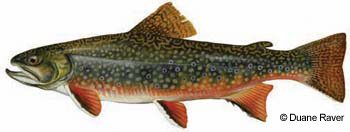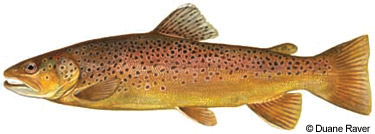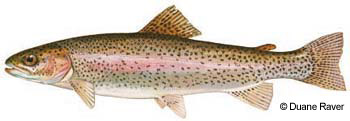North Carolina Trout Species
North Carolina Trout Species

Brook Trout are native to the eastern United States and Canada. Two strains of Brook Trout exist, and both are now found in North Carolina. The southern strain, although identical in appearance to the northern strain, is genetically unique and is native to North Carolina. Brook Trout can be distinguished by the olive-green coloration of the upper sides with mottled, dark green “worm-like” markings on their backs and tails. The lower sides are lighter with yellow spots interspersed with fewer spots of bright red surrounded by blue. The lower fins are orange with a narrow black band next to a leading white edge. Wild Brook Trout are most abundant in isolated, high-altitude headwater streams where the water is free of pollution and rich in oxygen. Brook Trout prefer streams with stable water flows, silt-free gravel for spawning and an abundance of pools and riffles with sufficient in-stream cover, such as logs and boulders. Young Brook Trout feed on small aquatic and terrestrial insects. Adults eat a wide variety of aquatic and terrestrial insects, as well as crustaceans, fish and other small vertebrates.
Brook, Brown and Rainbow Trout require cold, clean water and are therefore generally restricted to mountain streams and lakes. Those mountain waters that support trout and are open to public fishing are designated as “Public Mountain Trout Waters” by the Wildlife Resources Commission and are managed for public trout fishing. A significant number of trout fishing opportunities in western North Carolina are located on private property. These landowners have generously allowed public access for fishing. Please respect their property. Your cooperation is needed to protect fishing opportunities for future generations. The Commission conspicuously marks Public Mountain Trout Waters with regulation signs that indicate locations for public access. When anglers encounter “posted against trespass” signs along these designated sections on private lands, they should respect the property owner’s rights and choose another location along that stream to fish. Maps of trout water and their classifications may be viewed at ncwildlife.org/trout.

The Brown Trout is golden-brown to olive-brown with yellowish sides. Its back and sides have dark spots encircled with light yellow or white. Some Brown Trout also have orange or red spots on their sides. Native to Europe and western Asia, Brown Trout were introduced to North America in the late 1800s. Brown Trout are often reclusive, hanging out close to underwater structure, such as fallen trees and undercut banks. Larger specimens are often caught near dark and after rain storms that result in dingy water. Young Brown Trout feed on small aquatic and terrestrial insects. Adult Brown Trout usually reach larger sizes than Brook Trout or Rainbow Trout. As a result, they often consume larger food items, such as crayfish, mollusks and fish, including other trout.
Brook, Brown and Rainbow trout require cold, clean water and are therefore generally restricted to mountain streams and lakes. Those mountain waters that support trout and are open to public fishing are designated as “Public Mountain Trout Waters” by the Wildlife Resources Commission and are managed for public trout fishing. A significant number of trout fishing opportunities in western North Carolina are located on private property. These landowners have generously allowed public access for fishing. Please respect their property. Your cooperation is needed to protect fishing opportunities for future generations. The Commission conspicuously marks Public Mountain Trout Waters with regulation signs that indicate locations for public access. When anglers encounter “posted against trespass” signs along these designated sections on private lands, they should respect the property owner’s rights and choose another location along that stream to fish. Maps of trout water and their classifications may be viewed at ncwildlife.org/trout.

The Rainbow Trout is named for the broad, lateral stripe on its sides, which ranges from pink to red. Its back is olive-green, and its belly is whitish with heavy black speckling on all fins and the entire body. Rainbow Trout are native to the Pacific drainages of western North America but have been introduced throughout mountain streams in North Carolina. As with other trout, rainbows inhabit streams, rivers, ponds and lakes with good water quality and temperatures that rarely exceed 70 F. They have a tendency to hang out in faster currents, such as riffles and swift runs, more so than Brook Trout or Brown Trout. Young Rainbow Trout feed on small aquatic and terrestrial insects. Adults eat a wide variety of aquatic and terrestrial insects, as well as crustaceans, fish and other small vertebrates.
Brook, Brown and Rainbow trout require cold, clean water and are therefore generally restricted to mountain streams and lakes. Those mountain waters that support trout and are open to public fishing are designated as “Public Mountain Trout Waters” by the Wildlife Resources Commission and are managed for public trout fishing. A significant number of trout fishing opportunities in western North Carolina are located on private property. These landowners have generously allowed public access for fishing. Please respect their property. Your cooperation is needed to protect fishing opportunities for future generations. The Commission conspicuously marks Public Mountain Trout Waters with regulation signs that indicate locations for public access. When anglers encounter “posted against trespass” signs along these designated sections on private lands, they should respect the property owner’s rights and choose another location along that stream to fish. Maps of trout water and their classifications may be viewed at ncwildlife.org/trout.
